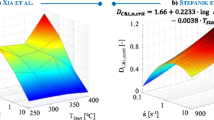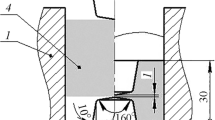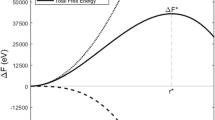Abstract
A numerical algorithm based on the element deletion method and rigid-viscoplastic finite element approach depending on Cockcroft-Latham and specific plastic work fracture criteria was applied to predict formation and evolution of possible cracking in a cold extrusion of aluminum and steel alloys. The Cockcroft-Latham fracture criterion induced an internal crack while an external crack occurred owing to the specific plastic work criterion in simulations. As a result, the Cockcroft-Latham criterion was found to be valid for predicting chevron cracking in comparison with the experimental observation available in the literature. Using the Cockcroft-Latham criterion, cracking was carefully investigated in terms of the size of the crack and gap distance between cracks depending on the number of elements and boundary condition at the punch interface. The critical damage values for the Cockcroft-Latham fracture criterion were also calculated based on the tensile instability and fracture conditions to investigate their effect on possible cracking. Finally, a processing map based on the Cockcroft-Latham fracture criterion for preventing chevron cracking in the cold extrusion of commercially available steel alloy was developed by considering processing parameters such as reduction in area and semicone angle. According to this investigation, the developed element deletion method with the Cockcroft-Latham fracture criterion was reasonably accurate for carrying out chevron cracking analyses in the cold extrusion with proper selection of a critical damage value.
Similar content being viewed by others
References
A. M. Freudenthal, The inelastic behavior in solids, 1st ed., Wiley, New York (1950).
M. G. Cockcroft and D. J. Latham, Ductility and workability of metals, J. Inst. Met., 96 (1968) 33–39.
S. E. Clift, P. Hartley, C. E. N. Sturgess and G. W. Rowe, Fracture prediction in plastic deformation processes, Int. J. Mech. Sci., 32 (1990) 1–17.
A. S. Wifi, A. N. Abdel-Hamid and E. Abbasi, Computeraided evaluation of workability in bulk forming processes, J. Mater. Process. Technol., 77 (1998) 285–293.
H. S. Kim, Y. T. Im and M. Geiger, Prediction of ductile fracture in cold forging of aluminum alloy, J. Manuf. Sci. Eng. Trans. ASME, 121 (1999) 336–344.
B. Avitzur, Analysis of central bursting defects in extrusion and wire drawing, J. Eng. Ind. Trans. ASME, 90 (1968) 79–91.
Z. Zimerman, H. Darlington and E. H. Kottcamp Jr., Selection of operating parameters to prevent central bursting defects during cold extrusion, Wire J. Int., 16 (1983) 64–68.
Z. Zimerman and B. Avitzur, Analysis of the effect of strain hardening on central bursting defects in drawing and extrusion, J. Eng. Ind. Trans. ASME, 92 (1970) 135–145.
N. Aravas, The analysis of void growth that leads to central bursts during extrusion, J. Mech. Phys. Solids, 34 (1986) 55–79.
K. Saanouni, J. F. Mariage, A. Cherouat and P. Lestriez, Numerical prediction of discontinuous central bursting in axi-symmetric forward extrusion by continuum damage mechanics, Comput. Struct., 82 (2004) 2309–2332.
C. McVeigh and W. K. Liu, Prediction of central bursting during axi-symmetric cold extrusion of a metal alloy containing particles, Int. J. Solids Struct., 43 (2004) 3087–3105.
J. O. Hallquist, LS-DYNA theory manual. Livermore Software Technology Corporation, USA (1998).
ANSYS Advanced Analysis Techniques Guide, ANSYS Release 10.0, ANSYS Inc. Canonsburg, USA (2005).
H. S. Alsos, A comparative study on shell element deletion and element splitting, Impact & Crashworthiness Laboratory, Report No. 127, MIT (2004) 1–94.
E. Ceretti, P. Fallbömer, W. T. Wu and T. Altan, Application of 2D FEM to chip formation in orthogonal cutting, J. Mater. Process. Technol., 59 (1996) 169–180.
H. C. Lee, J. S. Choi, K. H. Jung and Y. T. Im, Application of element deletion method for numerical analyses of cracking, J. Achievements Mater. Manuf. Eng. 35 (2009) 154–161.
S. Y. Kim and Y. T. Im, Three-dimensional finite element analysis of non-isothermal shape rolling, J. Mater. Process. Technol., 127 (2002) 57–63.
D. Y. Kwak, J. S. Cheon and Y. T. Im, Remeshing for metal forming simulations part I: Two-dimensional quadrilateral remeshing, Int. J. Numer. Methods Eng., 53 (2002) 2463–2500.
K. Komori, Simulation of chevron crack formation and evolution in drawing, Int. J. Mech. Sci., 41 (1999) 1499–1513.
T. Altan, S. I. Oh and H. L. Gegel, Metal forming: fundamentals and applications, American Society for Metals, Metals Park, OH, (1983).
V. Nagpal, T. Altan and R. Gagne, Computer-aided design and manufacturing of dies for lubricated extrusion of shapes, J. Mech. Work. Tech., 1 (1977) 183–201.
Author information
Authors and Affiliations
Corresponding author
Additional information
This paper was recommended for publication in revised form by Associate Editor Youngseog Lee
Jun-Seok Choi received the B.S. in Mechanical Engineering from Kyungpook National University in 2008 and M.S. in Mechanical Engineering from KAIST in 2010. His research interests include Finite Element Method and Ultra-fine grained material (ECAE).
Hyun-Chul Lee received the B.S. in Mechanical Engineering from KAIST in 2004. He is a Ph.D. candidate at KAIST. His research interests include Process Design and Finite Element Analysis for Net-shape forming.
Y. T. Im received B.S. & M.S. from Seoul National Univ. and Ph.D. from Univ. of Cal., Berkeley in 1985. He was an Asst. Prof. at the Department of Industrial & Systems Engineering at the Ohio State University from 1986 to 1989. His research interest is computer-aided-materials processing.
Rights and permissions
About this article
Cite this article
Choi, JS., Lee, HC. & Im, YT. A study on chevron crack formation and evolution in a cold extrusion. J Mech Sci Technol 24, 1885–1890 (2010). https://doi.org/10.1007/s12206-010-0605-z
Received:
Revised:
Accepted:
Published:
Issue Date:
DOI: https://doi.org/10.1007/s12206-010-0605-z




